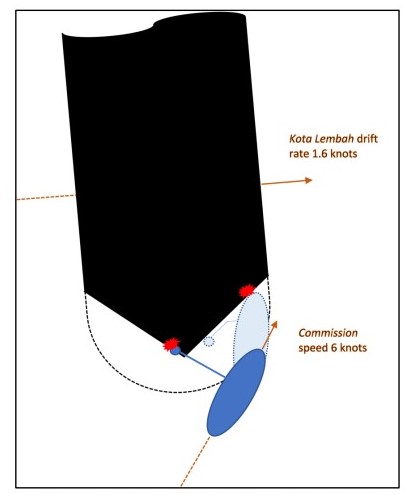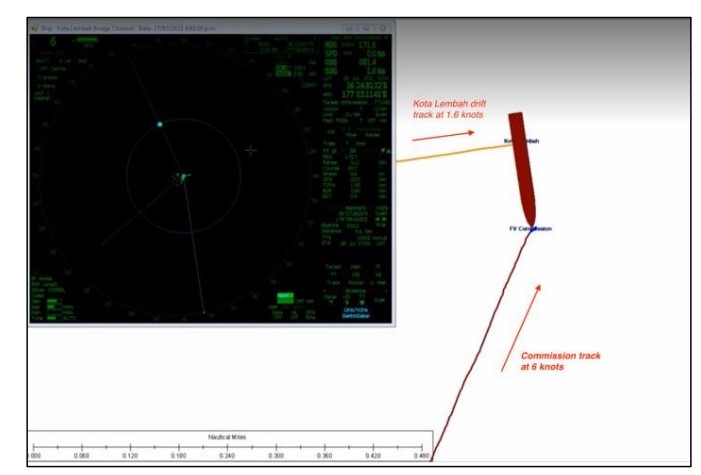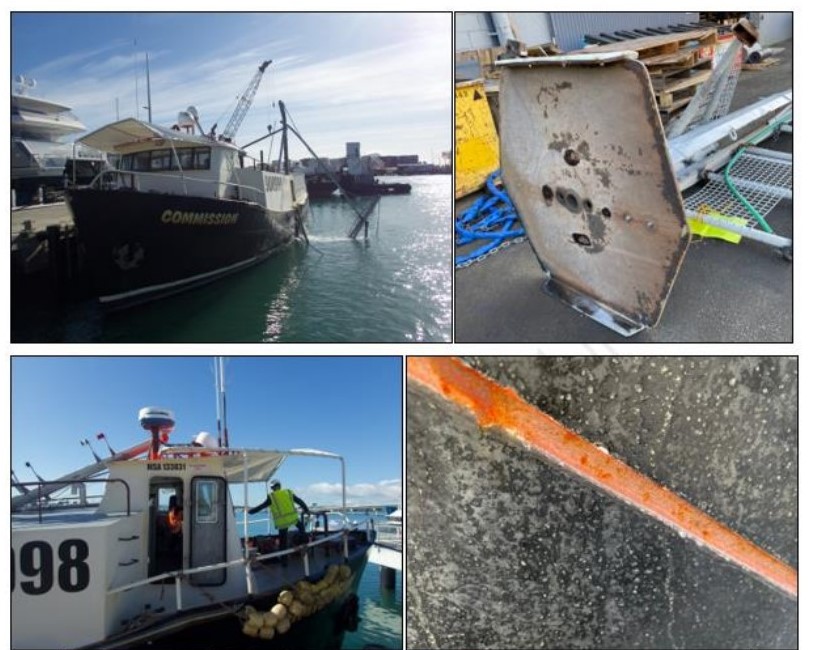New Zealand’s Transport Accident Investigation Committee (TAIC) issued an investigation report on the collision between the Fishing Vessel “Commission” and the containership “Kota Lembah” 84 nautical miles northeast of Tauranga, Bay of Plenty, New Zealand, in 28 July 2021.
The incident
On board the F.V. Commission
The F.V. Commission is a 19.5-metre longline fishing vessel. It left Napier on 22 July 2021 with the skipper, two deckhands and an observer from the Ministry for Primary Industries (MPI) on board. The skipper planned to fish in the area off East Cape and in the Bay of Plenty. The crew made one set of the longline off East Cape and then spent the following three days drifting, waiting for the weather conditions to abate.
[smlsubform prepend=”GET THE SAFETY4SEA IN YOUR INBOX!” showname=false emailtxt=”” emailholder=”Enter your email address” showsubmit=true submittxt=”Submit” jsthanks=false thankyou=”Thank you for subscribing to our mailing list”]
They set the longline again on the night of 26/27 July and then all three crew members slept for about 6 hours while the fishing line ‘soaked’. They began hauling the longline at 1430 on 27 July and had retrieved it and stowed the catch by 2200 that evening.
The F.V. Commission then motored for 4 hours to a new location and began setting the longline for a third time at 0200 on 28 July 2021. The operation involved laying out about 22 NM of line, periodically attaching baited hooks, flotation buoys and Global Positioning System (GPS) locator beacons.
The operation was undertaken at about 6 knots speed. The two deckhands were on the working deck paying the longline over the stern, attaching the hooks, buoys and occasional locator beacon as it went. The skipper was operating the vessel from the wheelhouse. The MPI observer was asleep in a cabin directly forward and below the wheelhouse.
The F.V. Commission was displaying the usual lights for a fishing vessel when engaged in fishing while ‘underway’. The weather was clear skies with a westerly wind blowing at 20 to 25 knots. It was dark but the meteorological visibility was good. There were 2 to 3-metre wind-waves from the west.
At about 0320 the skipper observed a target on the radar, nearly ahead of the F.V. Commission at 4 NM range. The vessel was later identified as the container ship Kota Lembah, which was stopped and drifting. The skipper assumed that because the F.V. Commission was fishing the Kota Lembah would keep clear of them. The skipper did not plot the Kota Lembah on the radar and did not look for it visually. By about 0330 about half of the longline (11 NM) had been deployed, at which point the deckhands attached one of the GPS locator beacons.
The F.V. Commission had previously developed a starboard list when the previous catch had been stowed. At about 0345 the skipper left the wheelhouse and went to the engine room to correct the list by transferring fuel. While the skipper was in the engine room the F.V. Commission was being steered by autopilot in the wheelhouse. Engine control had been transferred to alternative engine controls on the working deck, where the deckhands could work the engine if required.
The F.V. Commission was fitted with a retractable stabiliser arm, which was deployed on the port side. The stabiliser arm is a structure that is dragged through the water to help alleviate any rolling motion. At 0401:40 the F.V. Commission crossed the Kota Lembah’s bow with the narrowest of margins; so close that the stabiliser arm collided with the stem of the ship’s bow. The F.V. Commission pivoted around the stabiliser arm and its port bow collided under the flare of the Kota Lembah’s port bow in the vicinity of where the ship’s port anchor was housed. Still on autopilot, and with its engine still driving ahead, the F.V. Commission slowly scraped along the ship’s hull, as it rose and fell with the waves.
The skipper was knocked down in the engine room, but not injured. The skipper climbed back to the wheelhouse. It was dark and all the skipper could see was the Kota Lembah’s housed anchor out of the port side wheelhouse window. The deck crew were unaware of what had happened. They made their way to the wheelhouse to don lifejackets. The skipper shouted down through the opening to the cabin below to alert the MPI observer, who had slept through the collision.
The skipper then put the engine in reverse and the F.V. Commission backed away from the Kota Lembah and stopped several hundred metres off the ship’s port bow. The crew made precautionary preparations for abandoning the vessel before making a damage assessment. It soon became apparent that the watertight integrity of the hull was intact. The skipper then attempted to contact the Kota Lembah by Very High Frequency (VHF) radio, but because the various communication antenna on top of the wheelhouse had been damaged this was unsuccessful.
The crew then severed the fishing line and departed the scene, heading for Tauranga some 70 NM to the west. The F.V. Commission arrived without further incident early the following day, 29 September 2021.

On board the Kota Lembah
The Kota Lembah departed the port of Lyttelton on 22 July 2021 bound for Auckland. Port congestion in Auckland meant a berth would not be available until 30 July. The ship slow-steamed up the east coast, and rather than proceeding direct to anchor off Auckland the ship stopped on 25 July 2021 and began several days of drifting in the Bay of Plenty, about 70 NM east of Tauranga
At 0000 hours on 28 July 2021, the Kota Lembah was drifting with its main engine on 30 minutes notice should it be required. The ship was displaying the required navigation lights for a ship its size when underway, as well as deck working lights aft and along either side of the main deck.
The second mate was on watch, supported by a watchkeeper Able Body Seaman (AB). The ship was pointing broadly south on a heading of 172o True, but was drifting sideways towards the east under the influence of the westerly wind.
At 0310 the AB reported to the second mate a small vessel (the F.V. Commission) 6–7 NM away and fine9 on the starboard bow. At 0323 the AB began plotting the F.V. Commission on the radar when it was about 3.8 NM away.
At 0330 a second watchkeeping AB took over the shift from the first. The first AB told the second AB about the F.V. Commission, which was by then about 3.1 NM away and still on the starboard bow. The second AB reported to the second mate that the F.V. Commission was showing a small Closest Point of Approach (CPA).
The second mate was not concerned. Having noted the F.V. Commission was doing about 6 knots, the second mate assumed that it was a fishing vessel. The second mate’s expectation was that fishing vessels usually altered course and would keep out of the Kota Lembah’s way, especially as the ship was drifting. Meanwhile the second AB was using a red laser pointer directed at the F.V. Commission to warn its crew of their presence.
At 0350 the second mate became concerned that the F.V. Commission was getting closer and did not appear to be altering course. At 0355 the chief officer arrived on the bridge to begin taking over the watch from the second mate. The chief officer spent a few minutes familiarising himself with the ship’s situation, and then went with the second mate to the electrical equipment room behind the bridge to investigate a water leak that had developed in there during the night.
At 0358 both were back on the bridge and the chief officer asked about the F.V. Commission, which was by then 0.5 NM away and still closing. At 0401 they lost sight of the F.V. Commission in the blind sector ahead of the ship caused by the container stow. At this distance the ship’s radar lost definition of the target and any displayed data became unreliable, and they were beginning to wonder what the F.V. Commission’s intentions were. They were more concerned about the possibility that the F.V. Commission’s crew might be attempting to board the Kota Lembah, rather than colliding with them.
At 0401:40 the F.V. Commission collided with the Kota Lembah, but the bridge crew said they did not see, hear or feel the collision. The chief officer and second mate sent the AB forward with a radio to investigate, while each went to a different bridge wing in an attempt to see what was occurring at the bow.
At about 0405 the F.V. Commission emerged from the Kota Lembah’s port bow and remained in the vicinity for about 10 minutes. The bridge crew then saw it heading away from their ship towards the west. They made no attempt to contact the F.V. Commission. Nothing was recorded in the bridge logbook and the master was not informed. The Kota Lembah resumed its voyage to Auckland the following day and berthed at Auckland on 30 July 2021.

Analysis
#1 Fatigue management on board fishing vessels
When undertaking commercial fishing operations, the crew are required to comply with the Health and Safety Work Act 2015 (HSWA). HSWA obligations are overseen by Maritime New Zealand (MNZ) and operators are required to provide evidence of compliance with the HSWA as part of their Maritime Safety Operating System (MOSS), as documented in their MTOP.
The HSWA identifies fatigue as a potential risk that is required to be managed. The responsibility for managing fatigue is shared between those conducting or in charge of the business and those employed to carry out the work. Regarding maritime activity, MNZ gives the following interpretation.
#2 Fatigue management on board the F.V. Commission
Safety issue – Although the MTOP referenced fatigue as a significant on board hazard, there was no evidence that the operator was properly auditing the actual application of fatigue management on board the F.V Commission.
Section 4 of the F.V. Commission’s MTOP contained the Health and Safety Policy for the vessel. The policy detailed the responsibilities of those involved in the vessel operation, as well the various measures to be undertaken to comply with the HSWA. This included safety procedures to be adhered to on board the vessel, and a means by which to identify and manage hazards.
The MTOP referenced fatigue as a ‘significant’ on board hazard. Fatigue was recorded as such in the F.V. Commission’s Hazard Identification Register. The skipper was listed as the person responsible for managing this hazard. The register noted that while fatigue could not be eliminated, steps could be taken to minimise its impact. The documented control by which to manage fatigue on board was stated as: maintain proper rest hours.
According to section 7 of the MTOP, one of the six Standing Orders for the vessel was: make sure crew are not fatigued while working. Section 4 listed examples of how to recognise the symptoms of alcohol or drug use or fatigue:
- Irritable
- Uncommunicative, or unclear when they speak
- Slur or muddle their speech
- Forget things quickly
- Cut corners when completing tasks
- Take out of the norm risks
- Miscalculate distance and time
- Clumsiness
- Obviously sleepy.
The MTOP falls well short of addressing the issue of fatigue. The statement ‘maintain proper rest hours’, while appropriate, was not achievable because insufficient resources were provided to achieve the desired outcome. The MTOP listed the skipper as being responsible for managing the hazard of fatigue, and yet they were the most vulnerable to succumbing to it.
While statements in a manual may well give the impression that the matter has been managed, a good audit would test to see how it was being achieved. This is discussed further in the following section. A recommendation has been made to the F.V. Commission’s owner/operator to review and amend the MTOP for management of fatigue on board.
Findings
The Kota Lembah was the ‘give-way’ vessel under the International Regulations for Preventing Collisions at Sea (COLREGS) – the F.V. Commission was the stand-on vessel. The Kota Lembah did not, and could not, take the correct action required under the COLREGS because its engine was not readily available for manoeuvring.
The F.V. Commission did not take the correct action required under the COLREGS when the Kota Lembah failed to give way because: there was nobody in the wheelhouse at the time of the collision; they had not previously maintained a proper lookout; and they had not established whether a risk of collision existed between it and the Kota Lembah.
The standard of watchkeeping on board the F.V. Commission did not meet the standards required in Maritime Rules Part 31 Crewing and Watchkeeping, neither in the period leading up to the collision, nor during routine fishing operations.
The standard of watchkeeping on board Kota Lembah in the period leading up to the collision did not give full effect to the COLREGS and was not consistent with good industry practice. It is about as likely as not that the F.V. Commission skipper’s decision-making was to some degree influenced by the effects of fatigue in the period leading up to the collision.
The skipper was the only qualified watchkeeper on board the F.V. Commission and the two deckhands were not sufficiently trained to conduct a watch, which meant it was almost certain that the F.V. Commission would not be able to achieve full compliance with the COLREGS and Maritime Rules Part 31 without the skipper becoming chronically fatigued during routine fishing operations.
There is mounting evidence that a compromise in crewing levels aimed at keeping small fishing vessel operations economically viable is resulting in fishing crews either not achieving full compliance with national and international legislation or operating when fatigued. Either way, the result will be a higher risk of these vessels being involved in collisions or groundings.
Probable cause
- The bridge team on the Kota Lembah had seen and were plotting the F.V. Commission on the radar, and despite the Kota Lembah being required to give way to the F.V. Commission under the applicable collision prevention rules, it did not do so.
- The watchkeeping standards on both vessels fell well short of good industry practice.
- It was about as likely as not that the F.V. Commission’s skipper was to some degree suffering from the effects of fatigue at the time.
The F.V. Commission’s crew had detected the presence of the Kota Lembah on radar but made no attempt to sight the ship or plot it on the radar. There was nobody keeping watch in the wheelhouse at the time of the collision
Lessons learned
#1 Adhering to the rules for preventing collisions at sea is the best defence against being involved in a collision. When one vessel deviates from these rules, the risk of collision will be significantly higher. When two vessels deviate from them a collision becomes almost inevitable.
#2 Fatigue adversely affects human performance and is known to contribute to accidents. Vessels must be resourced so that fatigue can be appropriately managed.
#3 Non-compliance with standards for achieving navigation safety is also known to contribute to accidents. Anyone involved in keeping a navigational watch needs to be knowledgeable about the collision prevention rules.
































































